There are times in life when shorter is sweeter and less is more. Consider this principle when it comes to mini courses. These bite-sized cousins of traditional online courses can be powerful tools for creators. But the why and the how may seem elusive at times. Below, we’ll dive into exactly what is a mini course and how to create a mini course that’s profitable and impactful.
{{minicourse-component="/blog-shortcodes/blog-popup"}}
What is a mini course?
When we refer to a mini course, we mean short online course that typically takes two hours or less to complete. They cover a hyper-specific topic and are often used as a marketing growth tool. And they might be repurposed content or a unit from a larger online course.
Examples of when you might create a mini course
- A marketing coach whose flagship product is a course about Instagram marketing for creatives might launch a mini course of a short tutorial on editing photos for Instagram.
- An online English teacher might have a flagship course on conversational English for Spanish-speakers, while their mini course covers only coffee shop vocabulary.
- A vegan blogger wishing to monetize their business, might plan to sell a full course on how to do a one-month plant-based detox but might launch a mini course on making just breakfast or plant-based smoothies.
Mini course sales page examples
Hilary Rushford of Dean Street Society teaches entrepreneurs to leverage Instagram and live video, and she has a free 10-day challenge mini course to promote her program, Elegant Excellence:

The DIY Guy Caleb Wocjik offers a starter class alongside a more robust (and more expensive) course on the same topic:
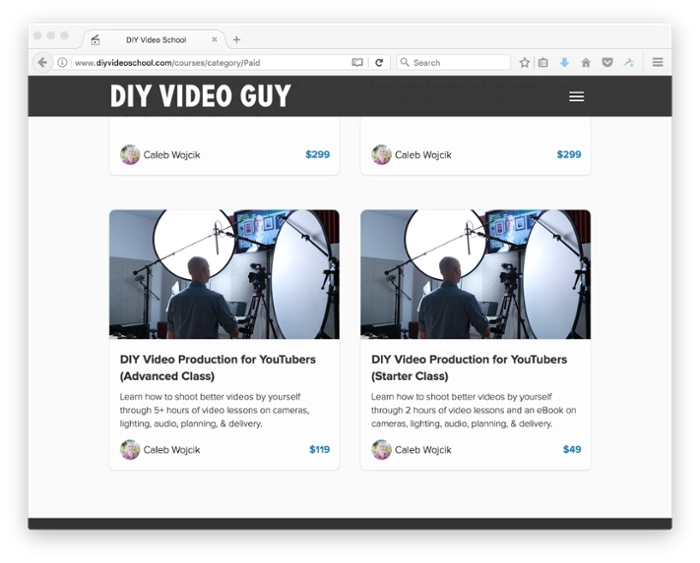
Why create a mini course
There are several benefits of a mini course. But consider the following questions from new course creators who often have the same recurring issues:
- Can I be sure that my course topic is going to be profitable?
- How can I find people to buy my course?
- How can I start making money online as a beginner with my online course?
- What’s the best topic to cover online? How am I going to translate my offline business into an online course?
A mini course to give some context and answers to these questions.
Creator mini course spotlight: Stefanie Dworkin
Teachable spoke to course creator, photographer, and video editor Stefanie Dworkin—who struggled with these exact worries above and decided the best first step to deal with these roadblocks was to create a mini course.
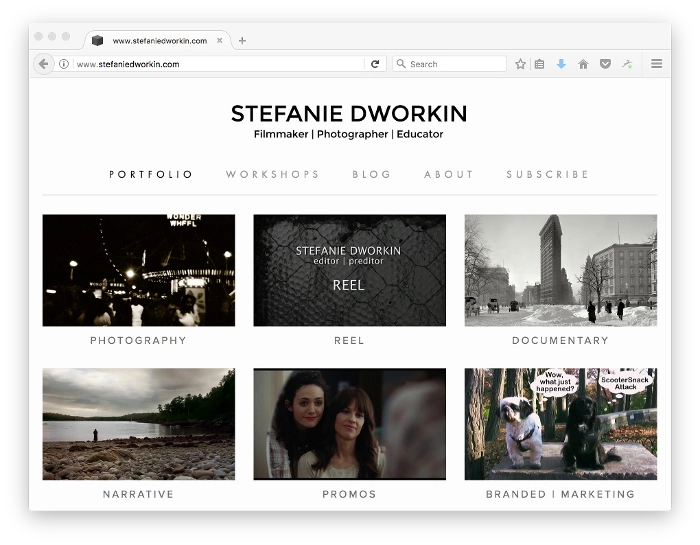
She spends most of her week editing video footage for clients, squeezing in time to send out her newsletter about once a month, and supplementing her income by teaching in-person classes at educational centers on various video topics.
When she began to look for a way to continue to diversify her income and her brand without burning herself out with in-person training and back-to-back client projects, she turned to online courses.
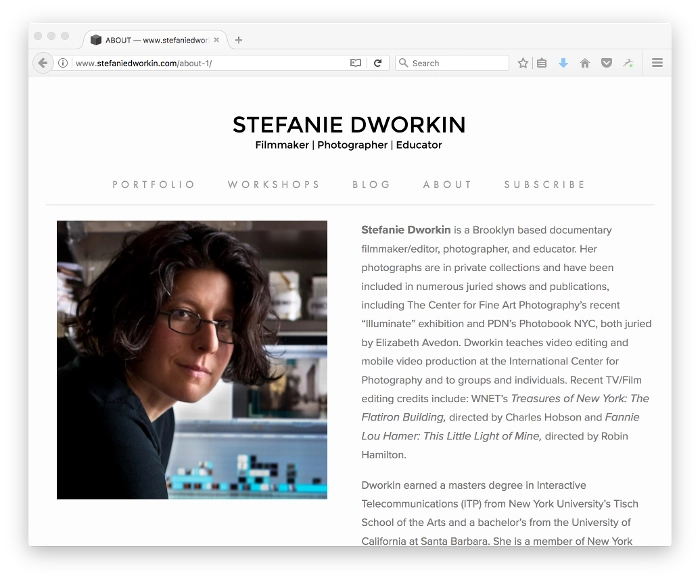
“I already was teaching iPhone video production classes around town when a student of mine suggested I take it online,” said Stefanie. “I had already been thinking to do this but wasn’t sure how to go about it.”
An online course allowed Stefanie to use her course curriculum over and over again, without adding more one-off classes to her schedule. And, if her course brought in enough income, she’d have more time and resources to spend on passion projects.
In practice, it’s not always obvious how to turn that vision into a reality.
What are the benefits and goals of a mini course?
1. To build an online audience
For creators whose biggest concern is finding and growing an online audience, a mini course is an incredible tool for doing so. Especially if offered for free and used as a lead magnet, or offered to students who pre-pay for the full course.
A mini course can earn creators recognition as an expert for a very specific topic. One creator at Teachable, Deborah Niemann, published a mini course on copper deficiency in goats to support her brand The Thrifty Homesteader. Her course encompasses everything from saving seeds to making eco-friendly, handmade skincare, and household products. In other words, a very specific topic can support a business in a larger niche.
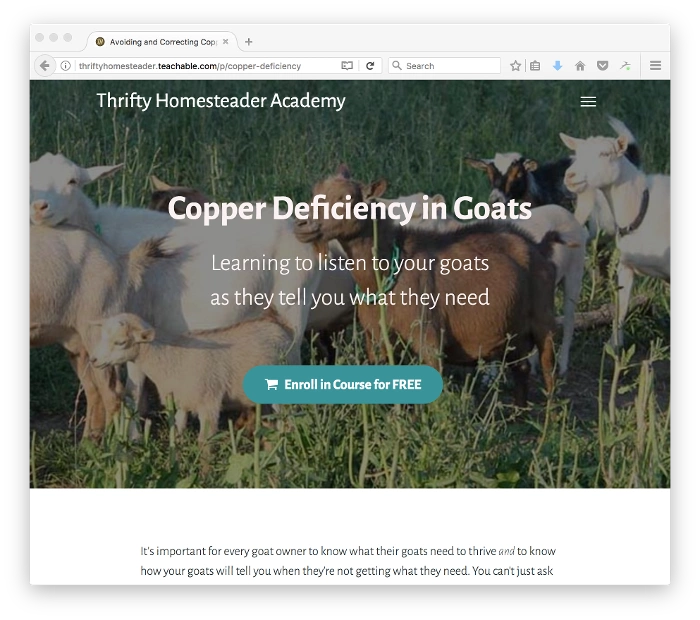
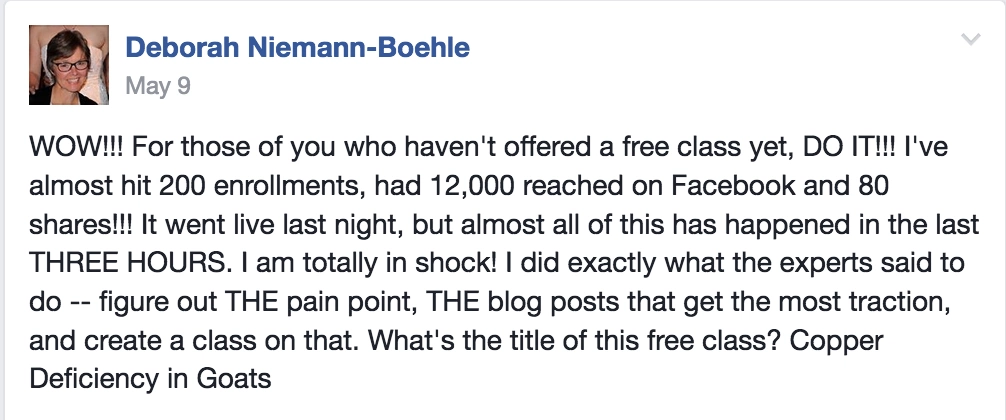
2. To narrow down a course topic
Mini courses help gauge demand for a topic before investing time and resources into a much larger course. If an audience buys or enrolls in the mini course, it’s likely a good sign they’re ready to purchase the full product. Then you can feel confident building out your content for a full course.
3. To start making money
If a creator is starting from scratch, just gaining a web presence, or is starting to think about how to translate their knowledge or content into an online course, the process and timeline can be daunting.
Creating a mini course, can shrink down that startup time and produce a profit quickly. Pro tip: Creators should repurpose content or choose a bite-sized topic they know like the back of their hand to start enrolling students in their mini course.
4. To start small (to eventually go big)
You have to walk before you run. A new course creator may not want to jump headfirst into a full curriculum. Biting off a smaller portion of a good idea helps a new course creator find their voice and build their business up.
How to create a mini course
Some creators fall into the trap of building a mini course that can be stand alone product. These can sell for hundreds of dollars. Keep the mini course small, simple, and short.
{{todolist-component="/blog-shortcodes/blog-popup"}}
1. Choose a course topic
For those:
- Who have content already: A blogger, a YouTuber, a podcaster, an Instagrammer, etc. may have all the content needed to create a mini course and already have an audience. In this case, take a look at analytics to understand which topics may be good for a mini course.
- With a strong email list: Here creators should find the intersection of the best performing content, the kind of content they’re passionate about, and their strongest areas of expertise, and go from there.
- Who are educators or trainers: Those in this position may be able to take a tiny slice of a training series or talk and break it down into a mini course fairly easily.
- Who run a service business: Consultants who provide the same services to different clients over and over again, may also be all set to create a mini course. The key is in breaking out a very small (but valuable) sliver of the whole picture.
- Starting from square one: Those who have been the go-to for friends and family members for the same topic over and over, or those who have unique training or experiences, might be positioned perfectly to create a course too.
See it in action: Stefanie Dworkin
Creator and educator Stefanie mentioned above had a handful of topics she could cover:
- Video Editing with Adobe Premiere Pro
- Video Editing with Apple Final Cut Pro
- How to Get Video Editing Clients
- Mobile Filmmaking
- Digital Photography
- Documentary Filmmaking
- Editing Movie Promos
- Holistic Health and Nutrition
- Vegetarian Cooking (Anti-Inflammatory)
But she only had a few she thought would be fun and interesting to create:
- Mobile Filmmaking
- Digital Photography
- Holistic Health and Nutrition
And she also had a few topics that would be simple to create:
- Video Editing with Adobe Premiere Pro
- Mobile Filmmaking
Use what you have
The last two topics also happen to be two topics Stefanie already taught in one-off workshops. And, she had lots of existing curriculum to draw from, was already an established authority on these topics, and had a sense of the demand for the material, thus making them more ideal candidates for longer courses.
The content for the mobile filmmaking workshop was more compact, and she was excited about becoming an authority in an emerging niche, so she went with Mobile Filmmaking for the topic of her mini course.
2. Identify the target audience
Scoping out and identifying an audience is key to success. One of the main ways to start this is to identify a particular group or community a creator is passionate about and wants to serve. Write and promote separate blog posts targeting those audiences and see which one garners the most attention and engagement to test.
Example: Stefanie Dworkin
Our creator Stefanie was involved in a couple of (official and unofficial) communities: She was a member of New York Women in Film and Television, was also interested in activism, and had a long-time interest in health and wellness.
Because she also had a particular passion for activism, she had a hunch that activists could put mobile filmmaking to work in places where bulky and expensive equipment might not be an option. Like at protests, rallies, and remote locales. And she had the sense that mobile filmmaking would appeal to influencers in the health and wellness scene. So she decided to keep her options open before deciding which audience has the most demand for her course.
{{minicourse-component="/blog-shortcodes/blog-popup"}}
For example, she could write two posts:
- How to Use Your iPhone to Get High-Quality Video at the Next Women’s March
- How to Create High-Quality YouTube Videos with just Your Smartphone
She could get these published as guest posts on niche blogs or just share them with her newsletter list and see which one gets more traffic, engagement, and social buzz.
Don’t skip research
The other essential part of audience identification is good old research. Type the term into the search bar in Facebook, look it up on Twitter, and browse hashtags on Instagram. Are there Quora questions on the topic? What are the answers like? This will give an idea of the communities your topic appeals to.
If we search Stefanie’s topic, “iPhone video editing,” there are lots of recent articles, but they are mostly reviews of apps, thus indicating there’s budding interest in this niche.
Of course, if a creator discovers a course already exists on their topic, there’s no need to panic. Simply examining the existing course to see if it’s targeting the same audience and if it’s doing so adequately can help determine if a new course will be successful. Identify what angles are missing and what new opportunities can be improved.
When analyzing Stefanie’s “iPhone video editing course” topic, we can see that there are definitely other courses out there. But on closer investigation, they’re not as thorough as Stefanie’s course, and they don’t target the same market.
Just remember: It’s always better to create a product or service so perfectly designed for a specific target audience that it’s an absolute no-brainer for them to buy it. Trying to appeal to everyone dilutes the course’s message and makes the product less appealing.
3. Provide a transformation
The best way to do this is to solve a real problem. Think about it this way: The target audience has a problem, and this course can solve it. For Stefanie, instead of just targeting bloggers, she could make it more specific by focusing on online influencers in the creative and lifestyle space looking to use video to grow but stumped by the technology.
Again, it all comes down to keeping things specific and pointed.
4. Outline the content
The very best way to do this is to take a look at the transformation students should experience through the course and work backwards.
When bringing this into reality for Stefanie, she would want students to be able to create high-quality smartphone videos quickly and easily by mastering:
How to shoot video on mobile:
- General
- Framing
- Zooming
- Lighting
- Audio
- Tips
- Gear
- iPhone
- Built-in camera
- Apps like Filmic Pro
How to edit video on mobile:
- General
- Transitions
- Cuts
- Text overlay
- Interstitial
- Music
- Video length
- Narrative arch
- iPhone
- Built-in video editor
- Apps like Filmic Pro
5. Shrink the list
Although Stefanie’s list is thorough, it’s still far too large for a mini course. The next step for any creator after making their list is to shrink that list even smaller.
Here’s an example of a few mini courses Stefanie might teach based on her list:
- Editing Video on the iPhone with iMovie
- Editing iPhone Video with Filmic Pro
- Shooting Video with the iPhone
- How to Get Good Audio with iPhone Video
- How to Shoot Engaging Online Video
The bottom line for all creators: Whatever topic is chosen, it should stand alone. In other words, even if it’s the only course a student ever takes, it should be enough to make them want to enroll in more courses.
Since video editing is a huge stepping stone for people and something that could help build Stefanie’s reputation as a trusted expert and major problem solver, she decided to make her mini course on: Editing Video on the iPhone with iMovie.
6. Repurpose content

Some creators will be able to repurpose content. In order to do so, first, decide which method of delivery is best for the unit: is it a video, a PDF, just a text lesson?
Video content is best for:
- Portraying ideas and concepts in three minutes or less
- Screencasts and walkthroughs, where students need to see the exact steps
Downloadable content is best for:
- Cheat sheets, glossaries, and other resources
- Worksheets
- Process documents like spreadsheets and other organizational tools
Text content is best for:
- Explaining a concept in more detail
- Showing step-by-step info
- Linking to other resources on the web
How to leverage a mini course to grow a business
Typically, creators have the big question of price looming over head: to charge or not to charge?
Regarding pricing
- First-time creators who don’t have an audience: A free course is an incentive for attracting people to sign up for emails prior to becoming customers. Use wording like “for a limited time” to drive urgency and convince more people to sign up while they can.
- First-time creators who DO have an audience: Charging is a great way to see if the public will put their money into an idea.
- Creators who already have a course and are using a mini course to test a new topic: Assuming there’s already a robust email list and clientele, charging is an excellent way to test the waters and see if an audience is ready to expand their learnings.
{{firstdigital-component="/blog-shortcodes/blog-popup"}}
The average Teachable course price is $179 (and higher for our top course creators). But, for a mini course, it makes sense to keep the price point lower to signify it isn’t a flagship course and presumably, took a little less time and resources to create.
In the end, pricing a mini course comes down to:
- What the creator is comfortable charging
- What the audience is willing/able to pay
- How the course compares to others in the same niche
The final countdown before launching a mini course
Consider this the mini course checklist every creator needs in order to go to market:
A course sales page: We created an entire mini course (with videos and walkthroughs) on exactly how to create a high-converting course sales page on Teachable.

An email list: Creators will be able to use their mini course as a list-building tool, but for other tips on growing an email list, refer to this post that handles all the ins and outs of emails.
Social media accounts: Consider Instagram Twitter, Pinterest, and even TikTok to market your course. Quora can also be an effective tool depending on the creator and audience.
How to market a mini course
There are many ways to launch a marketing strategy around a course, but some of the most successful ways for mini courses aren’t all that complicated.
Guest blogging
Write for other blogs featuring a topic covered in the mini course and target the same audience. For example, Stefanie can do a guest post covering her favorite iPhone photo and video editing apps, or how to find background music for iPhone video.
Before writing, consider if the blog even takes guests posts, if their audience is big enough to offer a high conversion rate, and most importantly, if they link and credit the post properly to drive business.
Organic social media marketing
This means linking the mini course sales page in any and every social media bio, posting frequently, engaging with the audience, and sharing related content.
Influencer outreach
Research influencers, bloggers, podcasters, Instagrammers, YouTubers, etc. who run powerful platforms related to the course. Offer them access for free and ask if they’re interested in sharing the mini course with their followers should they enjoy it.
With Teachable, creators can also offer affiliate revenue for anyone driving traffic to their course. (Read up on setting up affiliates here.)
In-person promotion
Those creators who already speak at or have in-person classes can leverage those appearances to drive new customers to their course.
Paid ads
This may not be the way to go for those just getting started. But those willing to invest time and energy might see a benefit paying for targeted ads.
Student referrals
Set up your student referrals so happy students can refer their friends. And then you can offer them both discounts on their next course.
Portions of this article were repurposed from a previous post from Randle Browning.
Join more than 150,000 creators who use Teachable to make a real impact and earn a real income.









